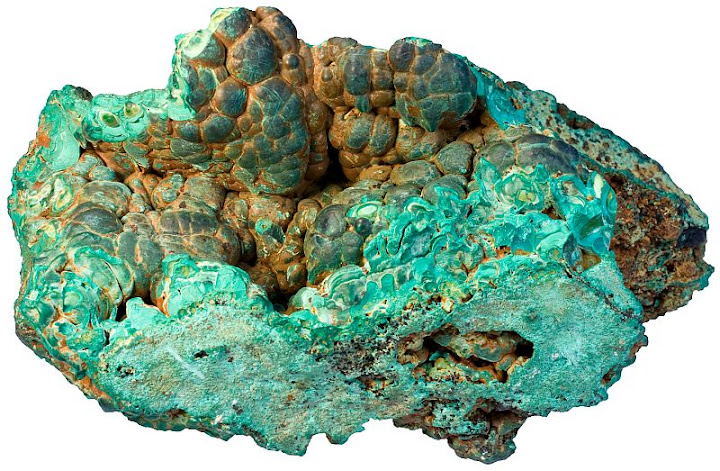Malachite is a green copper-bearing hydrated carbonate mineral (Cu2CO3(OH)2). Malachite is a minor ore of copper although it is usually used for ornamental purposes because of bright green color, interesting growth patterns and color variations. It is a well-known semi-precious gemstone.

Malachite commonly occurs as botryoidal aggregates (having a surface of spherical shapes). Here it occurs together with limonitic precipitates. Width of sample is 12 cm.
Malachite occurs in oxidized (weathered) parts of copper ore deposits (which is usually chalcopyrite). It is the most stable copper mineral in environments in contact with the atmosphere and hydrosphere. It also occurs as a stain on fractures in outcrops, as a corrosion product of copper and its alloys, and as suspended particles in streams and in alluvial sediments1.
There are other copper-bearing green minerals. Malachite can be distinguished from them quite easily because it is a carbonate mineral. Most carbonates, including malachite, are effervescent in dilute hydrochloric acid.
The formation of malachite starts with the dissolution of sulfide ore. Very acidic meteoric water (pH 2…3) is needed for that. Acidity is provided by the oxidation of sulfide minerals themselves, like pyrite and chalcopyrite. This results in sulfuric acid being produced in large quantities which is mixed with water and makes it very corrosive. Acidic water attacks the ore deposit and liberates copper from it. Copper-bearing meteoric water is then moving away from weathered ore and copper starts to precipitate when the acidic water encounters a neutralizer like limestone country rock or calcite vein. These materials and carbon dioxide also provide material for carbonate ions2. It is stable when the pH is over 5 and it precipitates above the water table.

Dirt from a copper mine dumps in Namibia. It is a mixture of several weathering products of copper ore like malachite, chrysocolla and chalcophyllite. Width of view 20 mm.

A mining hutch with rocks stained by malachite at Timna in Israel. Timna Valley in the Negev Desert is the location of the oldest copper mine in the world. Copper mining at Timna started approximately 6000 years ago.
References
1. Einaudi, Marco T. (2007). Malachite. In: McGraw Hill Encyclopedia of Science & Technology, 10th Edition. McGraw-Hill. Volume 10. 364.
2. Nesse, William D. (2011). Introduction to Mineralogy, 2nd Edition. Oxford University Press.
What is the age of this old mine ?. We have in Asturias prehistoric copper mines in Mestas de Con to compare
Copper mining at Timna started about 4000 BC.